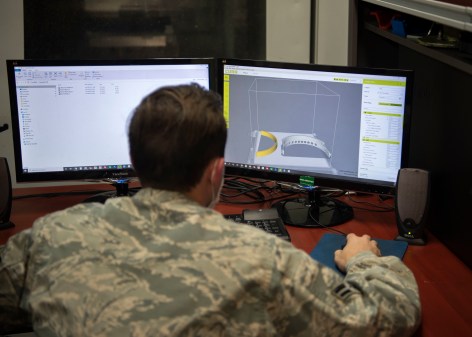 A soldier holds the Prox Dynamics’ PD-100 Black Hornet, a palm-sized miniature helicopter weighing only 16 grams. (Photo: Army)
A soldier holds the Prox Dynamics’ PD-100 Black Hornet, a palm-sized miniature helicopter weighing only 16 grams. (Photo: Army)Army researchers are focusing on two emerging technologies to rethink the way soldiers get their daily chow and how to keep them from blindly turning around the wrong corner during a firefight.
The U.S. Army Natick Soldier Research, Development and Engineering Center in Natick, Massachusetts, announced this week it is studying ways to leverage 3-D printing technology to deliver food to soldiers and developing pocket drones to spot enemies in combat situations. Both efforts, researchers said, represent leading-edge forays into bettering soldiers’ effectiveness and well-being.
Lauren Oleksyk, a food technologist leading the Army research team within the Combat Feeding Directorate, said 3-D printing food is revolutionary but not unheard of in the culinary world.
“Printing of food is definitely a burgeoning science,” Oleksyk said in a news release. “It’s currently being done with limited application. People are 3-D printing food. In the confectionery industry, they are printing candies and chocolates. Some companies are actually considering 3-D printing meat or meat alternatives based on plant products that contain the protein found in meat.”
For the Army, however, she said this is the first venture into this novel method of food production. Her unit recently visited with the Massachusetts Institute of Technology’s Lincoln Laboratory to discuss using the technology to make rations for soldiers.
“It could reduce costs because it could eventually be used to print food on demand,” said Mary Scerra, a food technologist on Oleksyk’s team. “For example, you would like a sandwich, where I would like ravioli. You would print what you want and eliminate wasted food.”
In its current form, 3-D printed food begins as a paste deployed through the printer connected to computer software. While an exact replica — either in taste or texture — of food items aren’t yet achievable, Oleksyk said the hope is the technology could provide nutrient-dense rations when needed on or near the battlefield to fit soldiers’ dietary needs.
“If you are lacking in a nutrient, you could add that nutrient,” she said. “If you were lacking protein, you could add meat to a pizza.”
Likewise, Natick researchers are also thinking of the soldiers after they’re full and healthy and called into battle. Focusing on a scenario where an individual solider is engaged in combat and poking his or her head around a corner is a risk, researchers in the Cargo Pocket Intelligence, Surveillance and Reconnaissance program are developing pocket-size drones to identify enemies and keep the soldier safe behind cover.
While larger drone devices have been used on the battlefield for different purposes over the past decade, Natick said the Prox Dynamics’ PD-100 Black Hornet, which is the size of soldier’s palm, is the first to deliver to an individual’s or squad’s needs.
“The Cargo Pocket ISR is a true example of an applied systems approach for developing new Soldier capabilities,” Dr. Laurel Allender, acting NSRDEC technical director, said in a statement. “It provides an integrated capability for the Soldier and small unit for increased situational awareness and understanding with negligible impact on Soldier load and agility.”
So, a solider entering a building with an unknown floor plan or holed up behind cover with no idea where enemy fire is coming from can identify danger in the nearby environment without risking injury or worse.
Researchers say more work still needs to be done before the pocket-drones will hit the battlefield. The devices need to be made compatible with Army communication standards and enhanced for better image capturing quality in adverse conditions, such as at night. In November, Natick researchers will take part in the Army Capabilities Integration Center’s Manned Unmanned Teaming (Ground) Limited Objective Experiment to showcase their development.




